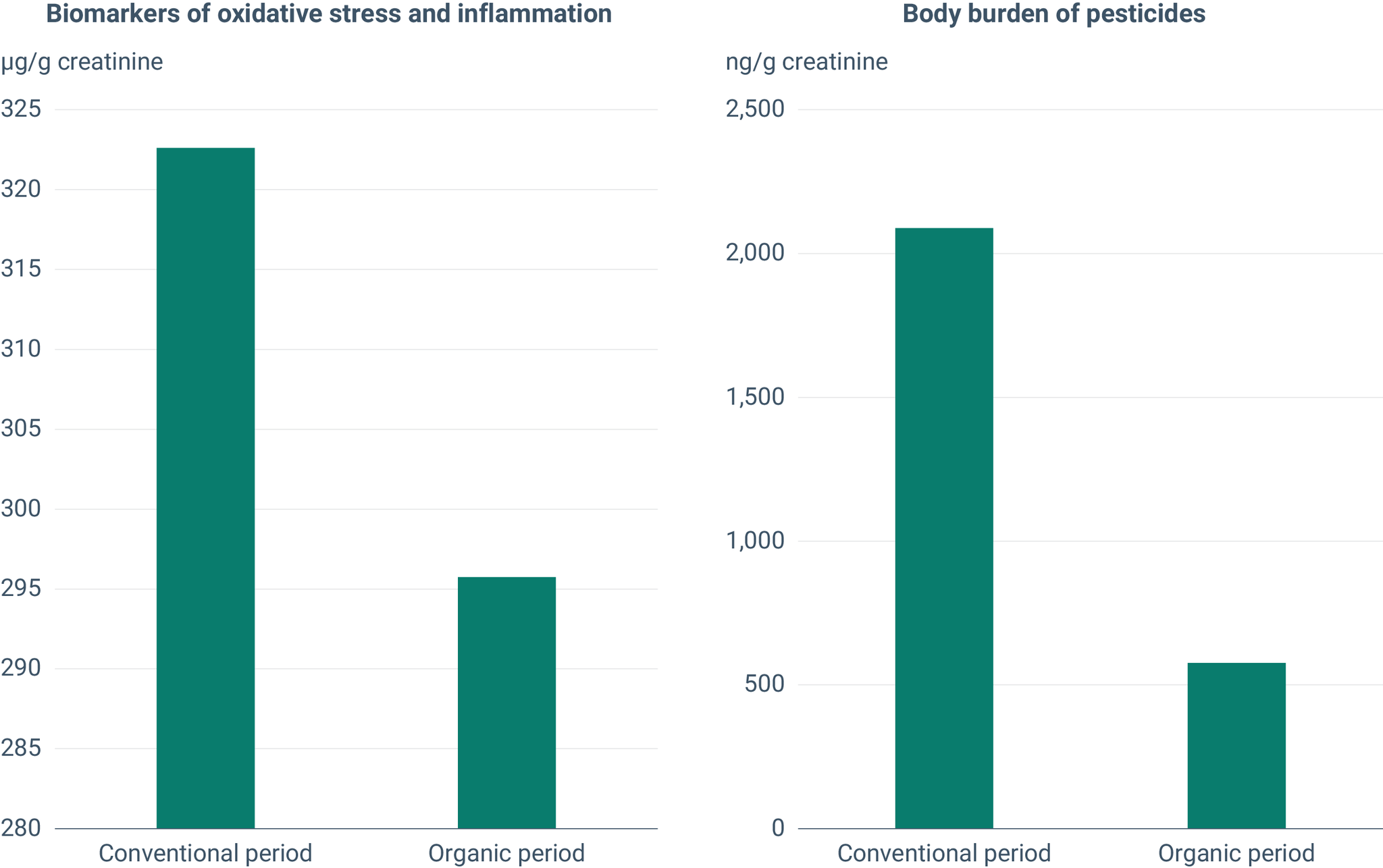Context
Pesticides impacting human health has been an issue of increasing concern in Cyprus in recent years. Over the past decade, Cyprus has consistently reported one of the highest rates of exceedance of maximum residue levels (MRLs) for pesticides in the EU. For example, 10% of fruit and vegetables sampled in 2020 exceeded MRLs for pesticides (EFSA, 2022). At the same time, Cyprus has seen increasing interest in organic farming: the area of land devoted to organic crops doubled from 2014 to 2021 (Eurostat, 2023).
Measures
The Organiko LIFE+ project aimed to demonstrate the comparative advantages of organic farming and its products over those of conventional farming. This included comparing pesticide exposure and health parameters in children consuming different diets. The study on ‘Organic diets and children’s health’ was conducted with around 150 children aged 10-12; they followed their regular diet for 40 days and an organic diet for another 40 days. Urine samples collected from the children were monitored for biomarkers of two pesticides, as well as biomarkers of oxidative damage, to investigate the impact on health[1].
Evidence of impact
The study demonstrated how an organic diet significantly reduces pesticide concentrations in children’s bodies and is associated with significantly lower levels of oxidative stress (Makris et al., 2019) (see Figure 1). For example, biomarkers for two types of pesticides, pyrethroids and neonicotinoids, were found to be below detection limits in 77% and 32% respectively of the urine samples with the organic diet, and 66% and 15% respectively with the conventional diet. In addition, switching from a conventional to organic diet for children’s meals in schools was cost-effective, supporting its broader implementation in Cyprus (McKinney and Makris, 2019).

Note: The left chart shows the concentrations of a urinary biomarker of oxidative stress/inflammation known as 8-hydroxy-2′-deoxyguanosine (8-OHdG) are presented. The right chart shows the concentrations of a urinary biomarker of pyrethroid pesticides known as 3-phenoxybenzoic acid (3-PBA). The lower levels of biomarkers of oxidative stress/inflammation and exposure to pyrethroids measured during the ‘organic’ period of the participants’ diets were statistically significant based on mixed-effect linear regression models.
Source: Organiko Life+ (2019).
Explore different chart formats and data here
The study’s findings informed the ongoing development of the National Action Plan for Organic Farming in Cyprus, expected to be published in 2023, which aims to increase organic farming and organic food consumption in Cyprus. Organic farming methods have the potential to improve soil fertility in the long term and substantially reduce greenhouse gas emissions compared to conventional farming techniques. The Organiko LIFE+ project team also participates in the Ministry’s newly formed national Farm to Fork Strategy Technical Committee, which oversees the implementation and coordination of actions and measures to deliver the objectives of the EU Farm to Fork Strategy in Cyprus.
The Horizon 2020-funded HBM4EU initiative used the work conducted in Organiko LIFE+ as a source of information (Vicente et al., 2022). Moreover, the project was included under the Agroecology Knowledge Hub database of the Food and Agriculture Organisation.
Lessons learned
- Switching to an organic diet decreased pesticide biomarker levels in children’s urine and was associated with a reduction in oxidative stress in primary school children.
- Providing organic food in school was found to be cost-effective in Cyprus.
| Location | Cyprus |
|---|
| Timeframe |
2015-2019 |
| Scale of measure |
City: The study was conducted in six schools in Limassol, Cyprus to observe the effects of organic food on children’s body health. |
| Pesticide(s) targeted |
Biomarkers of two key types of pesticides, pyrethroids and neonicotinoids, were investigated (6-CN and 3-PBA). |
| Measure led by |
Research project as part of a project under the EU LIFE programme (LIFE14 CCM/CY/000990), coordinated by the Cyprus International Institute for Environmental and Public Health, Cyprus University of Technology. |
Notes
[1] A biomarker is a measurable indicator that can be used to monitor health status. Biomarkers of exposure can be used to determine whether a chemical, such as a pesticide, has entered the human body.
References
EFSA, 2022, ‘National summary reports on pesticide residue analysis performed in 2020’, EFSA Supporting Publications 19(3), EN-7216 (DOI: 10.2903/sp.efsa.2022.EN-7216).
Eurostat, 2023, ‘Organic crop area by agricultural production methods and crops’, Eurostat Data Browser (https://ec.europa.eu/eurostat/databrowser/view/org_cropar/default/table?lang=en) accessed 23 March 2023.
Makris, K. C., et al., 2019, ‘A cluster-randomized crossover trial of organic diet impact on biomarkers of exposure to pesticides and biomarkers of oxidative stress/inflammation in primary school children’, PLOS ONE 14(9), e0219420 (DOI: 10.1371/journal.pone.0219420).
McKinney, A. and Makris, K., 2019, Ecosystem function restoration study: cost-effectiveness and ecosystem services associated with an organic diet treatment intervention in primary school children of Cyprus, Organiko LIFE+ (http://organikolife.com/wp-content/uploads/2019/10/Ecosystem-function-restoration-study.pdf) accessed 20 February 2023.
Organiko LIFE+, 2019, Layman’s report, Cyprus University of Technology (http://organikolife.com/wp-content/uploads/2019/11/Laymans-report-ENGLISH.pdf) accessed 24 March 2023.
Vicente, J. L., et al., 2022, Indicators using HBM-GVs — additional deliverable report AD5.8: WP5 — translation of results into policy, HBM4EU, Horizon2020 programme, European Commission (https://www.hbm4eu.eu/work-packages/additional-deliverable-5-8-indicators-using-hbm-gvs/) accessed 23 March 2023.

Document Actions
Share with others